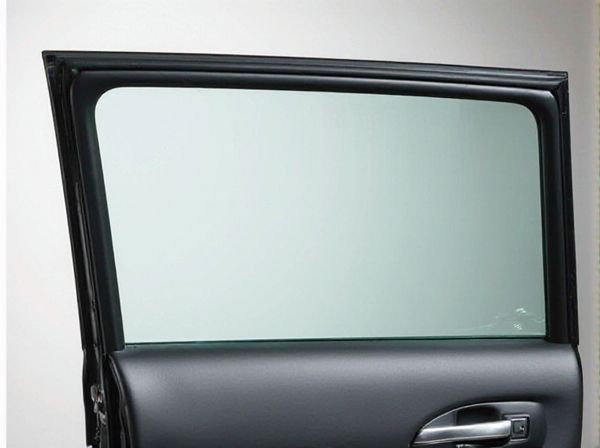
Photo illustration: Acoustic Glass vs Standard Automotive Glass
Acoustic glass significantly reduces road noise and vibrations, enhancing your driving comfort compared to standard automotive glass. It features laminated layers that dampen sound waves, providing a quieter cabin environment and improved insulation. Choosing acoustic glass can transform your vehicle into a more serene and enjoyable space.
Table of Comparison
| Feature | Acoustic Glass | Standard Automotive Glass |
|---|---|---|
| Noise Reduction | High; reduces exterior noise by up to 9 decibels | Low; minimal noise insulation |
| Glass Composition | Laminated with acoustic interlayer | Tempered or laminated without acoustic layer |
| Weight | Slightly heavier due to additional layers | Lighter by comparison |
| Durability | Enhanced resistance to shattering | Standard durability |
| Cost | Higher price point | More affordable option |
| Visibility | Clear with minimal distortion | Clear standard visibility |
| UV Protection | Better UV filtering capabilities | Basic UV protection |
Introduction to Automotive Glass Types
Automotive glass primarily consists of standard laminated glass and acoustic glass, each designed to meet specific performance criteria. Standard automotive glass offers basic durability and safety by employing a plastic interlayer that holds the glass shards together upon impact. Acoustic glass incorporates an additional specialized interlayer that significantly reduces external noise, improving cabin sound insulation and enhancing driving comfort.
What is Acoustic Glass?
Acoustic glass is a specialized type of automotive glass designed to reduce noise intrusion and enhance cabin comfort by incorporating a laminated layer that dampens sound vibrations. Unlike standard automotive glass, which typically consists of a single or tempered glass layer, acoustic glass uses a plastic interlayer that absorbs road, wind, and engine noise effectively. This technology significantly improves the overall driving experience by creating a quieter interior environment, especially beneficial in high-speed or urban settings.
Standard Automotive Glass Explained
Standard automotive glass primarily consists of tempered glass designed for durability and safety, shattering into small, blunt pieces upon impact to reduce injury risk. It is commonly used in side and rear windows of vehicles due to its strength and cost-effectiveness. Unlike acoustic glass, standard automotive glass lacks the laminated interlayer that provides noise reduction and enhanced insulation properties.
Key Differences Between Acoustic and Standard Glass
Acoustic glass features a special laminated structure with a viscoelastic interlayer that significantly reduces sound transmission, enhancing cabin noise insulation compared to standard automotive glass, which typically consists of single or laminated glass without this specialized soundproofing layer. Acoustic glass improves driver and passenger comfort by minimizing external noises such as traffic and wind, while standard glass primarily provides basic safety and visibility functions. The enhanced sound-dampening properties of acoustic glass usually come with slightly increased weight and cost but offer superior acoustic performance for luxury and noise-sensitive vehicles.
Sound Insulation Performance
Acoustic glass significantly enhances sound insulation performance by incorporating a special laminated layer that dampens external noise, reducing decibel levels by up to 15 dB compared to standard automotive glass. This improvement creates a quieter cabin environment, minimizing road, wind, and engine noise intrusion. Standard automotive glass, typically single-pane and untreated, lacks these laminated layers, resulting in higher noise transmission and less effective soundproofing.
Safety and Security Considerations
Acoustic glass offers enhanced safety by incorporating laminated layers that reduce shattering, providing better impact resistance compared to standard automotive glass. This specialized glass also improves security through its sound-dampening properties, making it harder for thieves to break in quietly. Standard automotive glass, typically tempered, may shatter into small pieces upon impact, posing a higher risk of injury and lower protection against forced entry.
Durability and Longevity Comparison
Acoustic glass features laminated layers that enhance strength and resistance to impact, providing superior durability compared to standard automotive glass, which is typically tempered and more prone to shattering. The specialized construction of acoustic glass helps it withstand daily wear, extreme temperatures, and road vibrations, extending its functional lifespan significantly over standard glass. Vehicles equipped with acoustic glass benefit from reduced maintenance and replacement frequency due to its enhanced longevity and resilience.
Cost Implications: Acoustic vs Standard Glass
Acoustic glass in automotive applications typically incurs higher upfront costs compared to standard automotive glass due to its multilayer laminated construction designed to reduce noise levels. While the initial investment is greater, acoustic glass can enhance driving comfort by minimizing road and wind noise, potentially increasing vehicle value and passenger satisfaction. Standard automotive glass, being more economical, offers basic protection and durability but lacks the advanced sound insulation properties of acoustic glass.
Installation and Maintenance Factors
Acoustic glass requires specialized installation procedures to preserve its soundproofing and vibration-dampening properties, often necessitating trained technicians to ensure a perfect fit and seal. Maintenance of acoustic glass involves careful cleaning with non-abrasive materials to avoid compromising its laminated layers, while standard automotive glass typically allows for easier installation and more straightforward upkeep with conventional cleaning products. The enhanced durability and noise reduction benefits of acoustic glass come with slightly higher installation complexity and maintenance vigilance compared to standard glass.
Choosing the Right Glass for Your Vehicle
Acoustic glass significantly reduces road noise by incorporating a special interlayer that dampens sound vibrations, making it ideal for luxury vehicles or drivers prioritizing a quieter cabin. Standard automotive glass, commonly laminated or tempered, offers adequate safety and durability but lacks the advanced soundproofing properties of acoustic glass. Choosing the right glass depends on balancing noise reduction preferences, budget constraints, and specific vehicle requirements such as manufacturer recommendations and compliance with safety standards.
 caratoz.com
caratoz.com